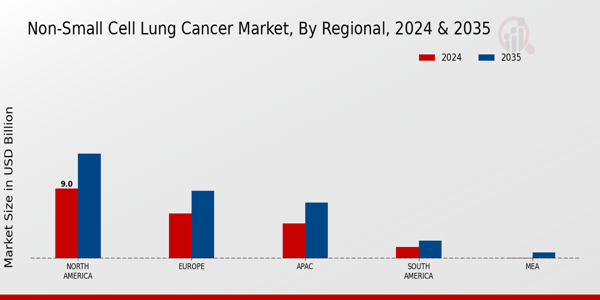Rising Incidence Rates
The Non-Small Cell Lung Cancer Market is significantly influenced by the rising incidence rates of lung cancer, which have been steadily increasing in various demographics. According to recent statistics, lung cancer remains one of the leading causes of cancer-related deaths, with non-small cell lung cancer accounting for approximately 85% of all lung cancer cases. This alarming trend is attributed to factors such as smoking, environmental pollutants, and genetic predispositions. As the population ages and exposure to risk factors persists, the demand for effective treatment options is expected to surge. Consequently, pharmaceutical companies are likely to invest heavily in research and development to address this growing need, thereby propelling the Non-Small Cell Lung Cancer Market forward. The urgency to combat this disease may also lead to increased funding for clinical trials and innovative therapies.
Advancements in Precision Medicine
The Non-Small Cell Lung Cancer Market is experiencing a notable shift towards precision medicine, which tailors treatment based on individual genetic profiles. This approach enhances the efficacy of therapies, as it allows for the selection of drugs that specifically target the molecular characteristics of a patient's tumor. Recent data indicates that approximately 30% of patients with non-small cell lung cancer may benefit from targeted therapies, which are designed to inhibit specific pathways involved in tumor growth. As research continues to unveil new biomarkers, the potential for personalized treatment regimens expands, thereby driving the demand for innovative therapies within the Non-Small Cell Lung Cancer Market. Furthermore, the integration of genomic testing into clinical practice is likely to facilitate earlier and more accurate treatment decisions, ultimately improving patient outcomes.
Emergence of Combination Therapies
The Non-Small Cell Lung Cancer Market is witnessing a paradigm shift with the emergence of combination therapies, which involve the use of multiple treatment modalities to enhance therapeutic efficacy. This approach is particularly relevant in the context of non-small cell lung cancer, where monotherapies may not yield optimal results for all patients. Recent studies suggest that combining immunotherapy with chemotherapy or targeted therapies can lead to improved survival rates and better management of the disease. As a result, pharmaceutical companies are increasingly focusing on developing combination treatment regimens, which are anticipated to capture a significant share of the Non-Small Cell Lung Cancer Market. The potential for synergistic effects among different therapeutic agents may not only improve patient outcomes but also expand the treatment landscape for this challenging disease.
Growing Awareness and Screening Initiatives
The Non-Small Cell Lung Cancer Market is experiencing a positive impact from growing awareness and screening initiatives aimed at early detection of lung cancer. Public health campaigns and educational programs are increasingly emphasizing the importance of recognizing symptoms and seeking timely medical attention. As awareness rises, more individuals are likely to undergo screening procedures, which can lead to earlier diagnosis and improved treatment outcomes. Recent data suggests that early-stage detection significantly enhances survival rates, thereby driving demand for effective therapies within the Non-Small Cell Lung Cancer Market. Additionally, healthcare providers are advocating for routine screenings, particularly among high-risk populations, which may further contribute to the growth of the market. This proactive approach to lung cancer management is expected to foster a more favorable environment for the development and adoption of innovative treatment options.
Increased Investment in Research and Development
The Non-Small Cell Lung Cancer Market is benefiting from increased investment in research and development, driven by the urgent need for more effective treatment options. Pharmaceutical companies and research institutions are allocating substantial resources to explore novel therapies, including targeted agents and immunotherapies. Recent funding trends indicate a growing interest in clinical trials aimed at evaluating new drug candidates and treatment combinations. This influx of investment is likely to accelerate the pace of innovation within the Non-Small Cell Lung Cancer Market, leading to the introduction of groundbreaking therapies that could transform patient care. Moreover, collaborations between academia and industry are fostering a conducive environment for scientific advancements, which may further enhance the development pipeline for non-small cell lung cancer treatments.


















Leave a Comment